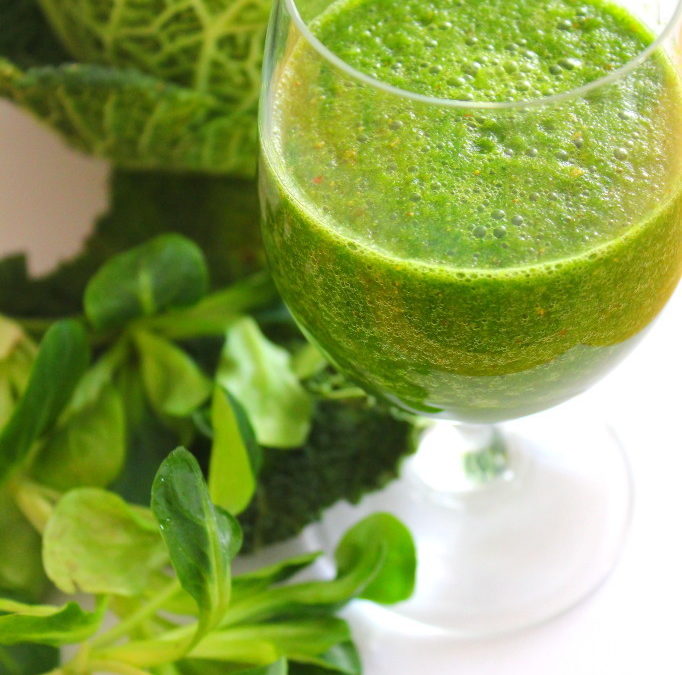They are what we have always dreamed of - sources of energy that do not burden the body. Whatever you want - they have it: green smoothies.
The green mixed drinks made from green leaves, fruit and water are extremely rich in protein, minerals and vitamins. With their micronutrient content, they far exceed our usual foods and also contain chlorophyll. And we have already explained the importance of micronutrients in the article 5 things you should know about antioxidants discussed. As you remember, we hardly consume enough antioxidants, no matter how healthy our diet is.
Green smoothies can be a huge help here.
Why chlorophyll?
Chlorophyll is the green pigment that is produced by reaction with light, which is why some call it "liquid light". It has a very favourable effect on our organism in several ways. It cleanses the blood and ensures new blood formation. It cleanses the intestines, deacidifies and prevents cancer. Chlorophyll supplies us with iron and cleanses the liver.
Dietary fibre
The German Nutrition Society recommends a daily fibre intake of 30 mg. However, we hardly consume more than 15 mg on average. The only foods that provide a high amount of fibre without being a burden are green leafy vegetables.
Forget salad!
What you consume in the form of a couple of leaves is cancelled out by the fatty dressing. Apart from that, lettuce cannot compete at all with green wild plants and leaves of root vegetables. Did you know that nettles have 30 times more calcium than lettuce or iceberg lettuce? See for yourself:
Nutrients in mg/100g
| Calcium | Magnesium | Iron | |
| Lettuce | 20 | 9 | 0,3 |
| Spinach | 117 | 58 | 4,1 |
| Iceberg lettuce | 19 | 5 | 0,4 |
| Nettle | 630 | 71 | 7,8 |
| French herb | 410 | 56 | 14 |
| Wild mallow | 200 | 58 | 5,1 |
This green comes in:
-
Wild herbs and garden herbs (dandelion, nettle, parsley, etc.)
-
Leaves from root vegetables (leaves from radishes, beetroot, kohlrabi - contain more nutrients than the bulb!)
-
Any kind of lettuce, spinach, cabbage
The basic recipe:
100 g green leafy vegetables
100 g fruit (bananas, apples, but also dried fruit)
100 - 200 ml water (depending on how liquid you want it)
Puree in a blender. This works quite well with a normal blender, but there are also special smoothie blenders.
Variations
The basic recipe is suitable because it only contains substances that are absorbed and utilised by the body very quickly and easily. Anything else you add can slow down the utilisation process, but is no less healthy for that. If you like, add a spoonful of honey, agave syrup, nuts or almonds. You can add a handful of rolled oats, but then it becomes a real meal. You can also use freshly squeezed fruit juice instead of water.
Important: the green smoothie commandments
-
The green smoothie should be salivated - that means you should chew it, even though it is liquid, so that it is better digested.
-
Start with small amounts and slowly acclimatise your body to this energy bomb.
-
Avoid blending for too long so as not to heat up the smoothie.
-
Pay attention to the quality of the ingredients.
-
The smoothie is a meal, not a drink.
Mix it smooth, baby!
As you can see, this drink is a rich source of vital energy. It has an enormously high micronutrient content and also contains secondary plant substances, chlorophyll and fibre. All this is contained in a quality that can be easily and quickly absorbed by the body.
I look forward to your comments, favourite recipes and experiences!
Sources: Peter, Christina: Green smoothies. In: besser leben 16/2010.
Unterweger Gerd, Unterweger Silvia: Hier finden Sie alles über grüne Smoothies. http://www.lebewesentlich.at/gr%C3%BCne-smoothies-rezepte/ Stand 12.3.2014
Centre for Health: Green smoothies - the perfect meal. http://www.zentrum-der-gesundheit.de/gruene-smoothies-ia.html As of 12.3.2014



